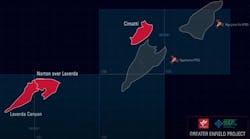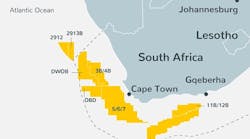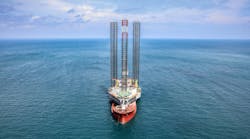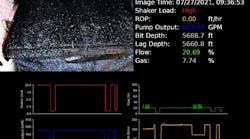John Skinner
Maarten Simon Thomas
F101 Consulting, LP
An offshore pipeline study for the Bureau of Safety and Environmental Enforcement (BSEE) was completed in May 2012. It was an assessment of the timeframe for flushing and filling out-of-service (OOS) pipelines based on the line's service.
Pipelines are the primary means for transporting gas and liquids in the petroleum industry. They typically are designed for a useful life of 20 or more years. The traditional lifecycle of pipelines includes design, fabrication, installation, pre-commissioning (hydrotest and dewatering), start up/commissioning, operation, and decommissioning. Periodically, an operating pipeline must be temporarily placed OOS and shut-in.
Reasons for this temporary OOS condition can be planned or unplanned and include platform turnaround, well workover, equipment availability, repair, and hurricane weather caused system shut in. Sometimes uncontrollable delays in sourcing equipment and other issues can extend the OOS time beyond what was expected. If the line is OOS for less than one year, then the line can be directly returned to operational service. However, if the line is OOS for more than one year, current BSEE regulations require the line to be flushed of hydrocarbon product, filled with inhibited seawater, and then hydro-tested before returned to service.
The study topic was deemed important by industry due to high costs and long delays associated with reinstating pipelines that are OOS for slightly more than one year due to storm or drilling- related schedule delays.
Currently, even a well-maintained gas flowline that is blown down to sub hydrostatic pressure and blanketed with nitrogen gas would still require being seawater flushed, filled and re-hydro tested if the OOS condition lasted more than 365 days. The additional delay, expense and hydrate-forming risks such a pipeline would see are not aligned with industry or regulatory interests.
Conversely, a less-maintained line with diagnosed microbial induced corrosion kept in check by chemical injections, or working in high H2S gas service that has a long, unplanned OOS condition, should not wait 365 days before flushing the product out with an inhibited seawater fill. The high-risk pipeline case like this is also not well aligned with industry or regulatory interests.
The current government regulation 30CFR250.1006 identifies a simple process for pipelines that are shut in, out-of-service, or idle for an extended period of time. The amount of time any pipeline is OOS is the only variable regarding its disposition.
The study used a risk-based approach involving industry representatives to determine how to safely improve the current one-year pipeline rule regarding flushing and filling. Flushing a pipeline's hydrocarbon product, filling the line with seawater, and if the line is to come back in service, re-hydro testing the pipeline and dewatering if in gas service – are all key issues. The time, expense, and risk of hydrate plug forming when re-hydro testing can be significant.
The goal of the study was to suggest improvements in the rule by identifying risk source and reducing or maintaining the risk level of the current rule. This was done by selectively modifying a given pipeline's flush and fill timeline based on the line's service and condition. Pipeline service and integrity-managed condition were deemed most influential when compared with pipeline material, design, age, and location.
Existing risk-based approaches from other regulatory codes and foreign best practices were considered by the study team. The risk-mitigating impact of using "inert" or non-corrosive fluids as a temporary line fill product for pipelines about to go into a planned shutdown condition was also considered.
The study researched OOS line failure reports, actual and theoretical root causes of OOS line failures, and domestic and international industry experience by performing a survey and conducting a workshop. The BSEE current prescriptive one-year rule's track record was good as no failures (due to OOS-related corrosion) have been clearly identified to date. However, good industry practice may have contributed to the rule's success in sour service cases, while the one-year rule appeared rather conservative for water injection and sweet gas service pipelines.
An industry workshop was held in December 2011 to gather interactive feedback from industry representatives and from the BSEE; to review and validate study assumption of OOS line failure mechanisms and their severity; and to assess the risk of various line types in various theoretical service conditions. This involved consideration of the line's service, integrity managed condition, and various fill fluids that could be used to preserve the line while out of service.
Companies involved in survey and workshop included Apache, Anadarko, BHP, Black Elk Energy, BP, Chevron, Exxon, Enbridge, Helix ERT, Marathon, Shell, and W&T Offshore.
Pipeline "service" cases included:
- Water: inhibited seawater for lines in water injection service. This category can also include lines with inert or safer environment products such on nitrogen gas, seawater, or glycol.
- Gas: non-sour bulk gas and gas/condensate service. "Non-sour" meaning low hydrogen sulfide (H2S) content in product. "Bulk" meaning raw production from a well, which includes gas and some liquid phase hydrocarbon components as well as water. This category can also included export grade natural gas.
- Oil: bulk oil service, which includes non-sour oil. It can consist of raw product flow from well in a flowline to export grade crude in a pipeline.
- Sour service: high H2S containing gas and or oil mixes. This can be highly corrosive and dangerous to human life.
The study team identified corrosion as the primary root cause of theoretically increased risk to a pipeline's integrity when it is OOS, versus in service. The concern was that subsea pipelines that sit "shut in or idle" with oil or gas product in them can, over time, have corrosion build up.
The definition of higher risk considered differential risk in a flowing versus stagnant or idle pipeline. When a line is shut in, temperature of the product drops, the fluid velocity drops to zero, and the components of the product settle out and separate. Line integrity is enhanced by the lower temperate and the lack of velocity-based erosion. But, lack of flow also allows water to settle on the bottom of the line, and for bacteria colonies to grow undisturbed while chemical injection chemistry settles out and becomes ineffective over time. The study found that there were two key corrosion risks for OOS pipelines: microbial induced corrosion (MIC) due to anaerobic sulfate reducing bacteria (SRB), and the rare cases of high H2S or acid containing products.
The key corrosion considerations for shut-in pipelines include:
- The CO2 corrosion threat becomes negligible. Lack of flow allows the development of corrosion products like iron carbonate scale, which greatly reduce further corrosion.
- H2S corrosion in the form of pitting, which is a threat in systems containing high concentrations of hydrogen sulfide.
- Oxygen corrosion will typically be limited, since O2 is consumed and then is normally not replenished while a line is shut-in, so its threat is self-limiting.
- The threat of microbial-induced corrosion (MIC) increases if nutrients are available in the fluid, because stagnant conditions are more conducive to proliferation of bacteria in bio-film inside the line.
- The risk of acid corrosion does not change significantly.
The pipeline systems were risk ranked using a criticality matrix. This structure considered both the probability and risk of a leak occurring as well as the likely consequence if said leak did occur.
Study results
Pipelines in water, non-sour bulk gas, and gas/condensate services were relatively low risk for elevated internal corrosion while shut in. Further risk reduction was noted by means of dosing the pipeline with methanol and biocide or by nitrogen packing the line before it goes OOS. Consequence of possible leaks if a product-filled line was brought back into service was noted as minimal for water injection and non-sour gas service.
Pipelines in bulk oil or oil with gas service were found to be relatively high risk for elevated internal corrosion. One method to reduce bacteria risk would be to carefully filter hydrotest water and dosing the line with biocide before it goes OOS. Pipelines in highly sour service were found to be high risk and treated as special cases.
Study recommendations
Inert fluid, sweet gas, bulk gas with minimal condensate, dead oil, or export-grade crude service lines were noted as the least likely to develop corrosion-based leaks. Assuming that documented evidence of proper line integrity management could be demonstrated, it was recommended that such lines be considered less risky and considered for an extended OOS term before seawater flush, fill, and pressure test are required. It was recommended that export-grade or dead oil service lines should be risk assessed more carefully, based on their potential for greater environmental consequence if external leaks occurred.
Other recommendations included:
- Water injection lines were deemed low criticality because the product in them is treated seawater and would have negligible environmental impact if a leak developed
- Bulk gas with condensate service lines were noted as having a medium likelihood of developing corrosion-based leaks
- Bulk oil and highly sour service gas service lines were noted as having a high likelihood of developing corrosion-based leaks
- Highly sour service OOS lines should be inert fluid "pickled" as soon as possible and, or flushed and filled with seawater in a reduced period
- Risk mitigation actions can effect the OOS timeline required before seawater flush and fill. These actions include:
- –Pipeline depressurization before going OOS
- –Preventing and avoiding the presence of harmful bacteria (SRB) in any seawater introduced into the pipeline (i.e., hydrotest water)
- –Periodic recirculation of an OOS line (annually where practical)
- –Pickling the line segment with inert fluid (i.e., MEG, MEOH, or nitrogen gas) or with non-corrosive fluids such as dead oil or export grade crude.
The study analysis and workshop feedback supported a recommendation for safely changing the timeline-based criterion of 30CFR250.1006 to a risk-assessment based criterion along the lines of PHMSA and international regulatory practices. A suggested path forward included the use of a flowchart approach involving pipeline service and Pipeline Integrity Management Systems (PIMS) qualification of the pipeline's condition. Depending on service, risk mitigation action and PIMS results, the associated recommended OOS timelines range from six months for sour service to five years for water injection lines. It is hoped that this report will be useful during the current Subpart J code update activity that BSEE is working to finish.
It appears that many industry owner/operators could save over $20 million per year in direct costs alone with such a risk based approach regarding flush, fill and re-test timeline adjustments for OOS pipelines. Further, this type of approach is in line with international regulatory practices which also have a good safety track record.
Editor's Note: The following information is based strictly on the views of F101 Consulting and does not represent new rules, regulations, or guidance from BSEE.
Offshore Articles Archives
View Oil and Gas Articles on PennEnergy.com







